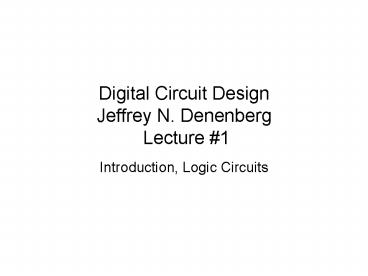Digital Circuit Design Jeffrey N. Denenberg Lecture PowerPoint PPT Presentation
1 / 18
Title: Digital Circuit Design Jeffrey N. Denenberg Lecture
1
Digital Circuit Design Jeffrey N. Denenberg
Lecture 1
- Introduction, Logic Circuits
2
Administrative
- Handouts
- Course Syllabus (readings due before
lecture)http//DoctorD.WebHop.net - Linked Resources on Syllabus
- Grading
- 20 Homework (Due the week following the lecture
on that topic) - 2 midterms (40) cumulative final (40)
- all exams required make arrangements in advance
if you have a conflict. - Lab Note You should prepare prior to Lab session
- Paper design (if required)
- Functioning simulation
3
Number Systems
- Radix 10 Why? (0, 1, 9)
- 5,273 5103 2102 7101 3100
- Binary Radix 2 (0,1)
- On/off
- 153 27 23 20 10001001
- Octal Radix 8 (0, 1, 7)
- 153 2 82 381 80 231
- Hexadecimal Radix 16 (0, 1, 9, A, F)
- 153 9161 9160 99
4
Complements(Representing Negative Numbers)
- Signed-magnitude Binary
- 9 00001001
- -9 10001001
- 1s complement (complement all bits)
- -9 11110110
- 2s complement (add 1 to the 1s complement)
- -9 11110111
0
000
-1
1
001
101
Sign bit
2
-2
010
101
3
-3
011
111
5
Illustrative Example 9s Complement
- Decimal Subtraction
- 575 - 57 518
- 9s Complement
- -057 942 575 1517now wrap the
overflow around and add for the answer - 518
- 10s Complement
- -057 9421 943 575 1518Here
ignore the overflow to get 518
6
Other Codes
- BCD (10, 4-bit binary codes per digit)
- Gray Code
- only one bit changes between adjacent Digits
- ASCII
0 1 2 3 4 5
6 7 8 9 A B C D
E F 0 NUL SOH STX ETX EOT ENQ ACK BEL BS
HT LF VT FF CR SO SI 1 DLE DC1 DC2
DC3 DC4 NAK SYN ETB CAN EM SUB ESC FS GS RS
US 2 SP ! "
' ( ) ,
- . / 3 0 1 2 3
4 5 6 7 8 9
lt gt ? 4 _at_ A
B C D E F G H
I J K L M N O 5 P
Q R S T U V W X
Y Z \ _ 6
a b c d e f
g h I j k l
m n o 7 p q r s t
u v w x y z
DEL
7
Digital Logic
- Binary system -- 0 1, LOW HIGH, negated and
asserted. - Basic building blocks -- AND, OR, NOT
8
Digital Logic Continued
9
Many representations of digital logic
- Transistor-levelcircuit diagrams
- Gate symbols (for simple elements)
10
- Truth tables
- Logic diagrams
11
- Prepackaged building blocks, e.g. multiplexer
- Equations Z S A S B
12
- Various hardware description languages
- ABEL
- VHDL
- Well start with gates and work our way up
13
Logic levels
- Undefined regionis inherent
- digital, not analog
- amplification, weak gt strong
- Switching threshold varies with voltage, temp,
process, phase of the moon - need noise margin
- The more you push the technology, the more
analog it becomes. - Logic voltage levels decreasing with process
- 5 -gt 3.3 -gt 2.5 -gt 1.8 V
14
MOS Transistors
Voltage-controlled resistance
PMOS
NMOS
15
CMOS Inverter
16
Switch model
- Simplified Inverter Model
17
Alternate transistor symbols
- Inverter Again
18
CMOS Gate Characteristics
- No DC current flow into MOS gate terminal
- However gate has capacitance gt current required
for switching (CV2f power) - No current in output structure, except during
switching - Both transistors partially on
- Power consumption related to frequency
- Slow input-signal rise times gt more power
- Symmetric output structure gt equally strong
drive in LOW and HIGH states

